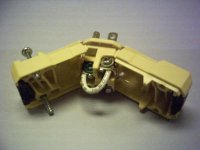After much consideration, I modified the generator to have a Floating Neutral and made up a plug that Bonds Neutral to Ground for standalone usage.
A clamp-on
meter from HF was used to test current draw on all my high usage items so I would know what combinations I am able to use with the genset at the same time.
I also mounted a remote 120v outlet on the front of my TSC carry-all for a
Kill-A-Watt that can be seen from the tractor seat (or from the ground) for properly setting frequency.
An outlet
tester shows proper configuration at 120v outlets in the home when the genset is connected and running, and the generator shows the same in standalone mode when using the bonding plug.
Yesterday I did a full test of the Generator and ran everything in the house, setting the frequency at 62hz with no load and then testing first lights, high usage items then electronics.
My high usage items are a 1.5hp 650ft well pump, electric dryer, range/stove, and a 4 ton central A/C unit.
The generator had no problems with any of these and will easily run the well pump with any other single high usage item along with lights, refrigerator/freezer, TV/Satellite and PC/Internet.
The Kubota has plenty of power with 37 PTO hp and I never saw lights flicker, the rpm vary much or the frequency go below 60hz under the highest loads.
This setup may not suit everyone but will provide emergency power to anywhere in my home and barn which is what I was after.
Thanks to all who responded, your advice was appreciated.
I would like to add a pilot light to the breaker box to tell me when grid power has been restored, if someone can point me to a link for a suitable Neon or LED light and holder that can be hooked to one side of my input power I would appreciate it.

